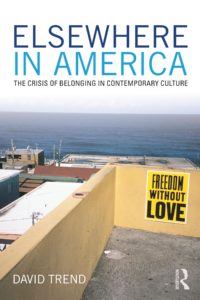It’s not always easy living up to one’s ideals, either personally or as a nation. Americans like to think of the United States as a welcoming place where everyone has equal chance. But historical baggage and anxious times can make such generosity difficult. Behind the America’s mythic open door, newcomers often find that civic belonging comes with strings attached––riddled with conditions, limitations, and in some instances, punitive rites of passage. And for those already here, new rationales emerge to challenge civic belonging on the basis of belief, behavior, or heritage. This book uses the term “elsewhere” in describing conditions that exile so many citizens to “some other place” through prejudice, competition, or discordant belief. Even as “diversity” has become the official norm in American society, the country continues to fragment along new lines that pit citizens against their government, each other, and even themselves. Yet in another way, “elsewhere” evokes an undefined “not yet” ripe with potential. In the face of daunting challenges, elsewhere can point to optimism, hope, and common purpose.
Behind the America’s mythic open door, newcomers often find that civic belonging comes with strings attached––riddled with conditions, limitations, and in some instances, punitive rites of passage. And for those already here, new rationales emerge to challenge civic belonging on the basis of belief, behavior, or heritage. This book uses the term “elsewhere” in describing conditions that exile so many citizens to “some other place” through prejudice, competition, or discordant belief. Even as “diversity” has become the official norm in American society, the country continues to fragment along new lines that pit citizens against their government, each other, and even themselves. Yet in another way, “elsewhere” evokes an undefined “not yet” ripe with potential. In the face of daunting challenges, elsewhere can point to optimism, hope, and common purpose.
Elsewhere in America uses the concept of “belonging” to frame a uniquely multidisciplinary exploration of division and marginalization in the U.S.––in a study encompassing material conditions, discursive contexts, and affective states. Through 12 detailed chapters, Elsewhere in America applies critical theory in the humanities and social sciences in examining recurring crises of social inclusion in the U.S. After two centuries of struggle and incremental “progress” in securing human dignity, today the U.S. finds itself riven apart by new conflicts over reproductive rights, immigration, health care, religious extremism, sexual orientation, mental illness, and fears of terrorists. Why are U.S. ideals of civility and unity so easily hijacked and confused? Is there a way of explaining this recurring tendency of Americans to turn against each other? Elsewhere in America engages these questions in charting the ever-changing faces of difference (manifest in contested landscapes of sex and race to such areas as disability and mental health), their spectral and intersectional character (as seen in the new discourses on performativity, normativity, and queer theory), and the grounds on which categories are manifest in ideation and movement politics (seen in theories of metapolitics, cosmopolitanism, dismodernism).
